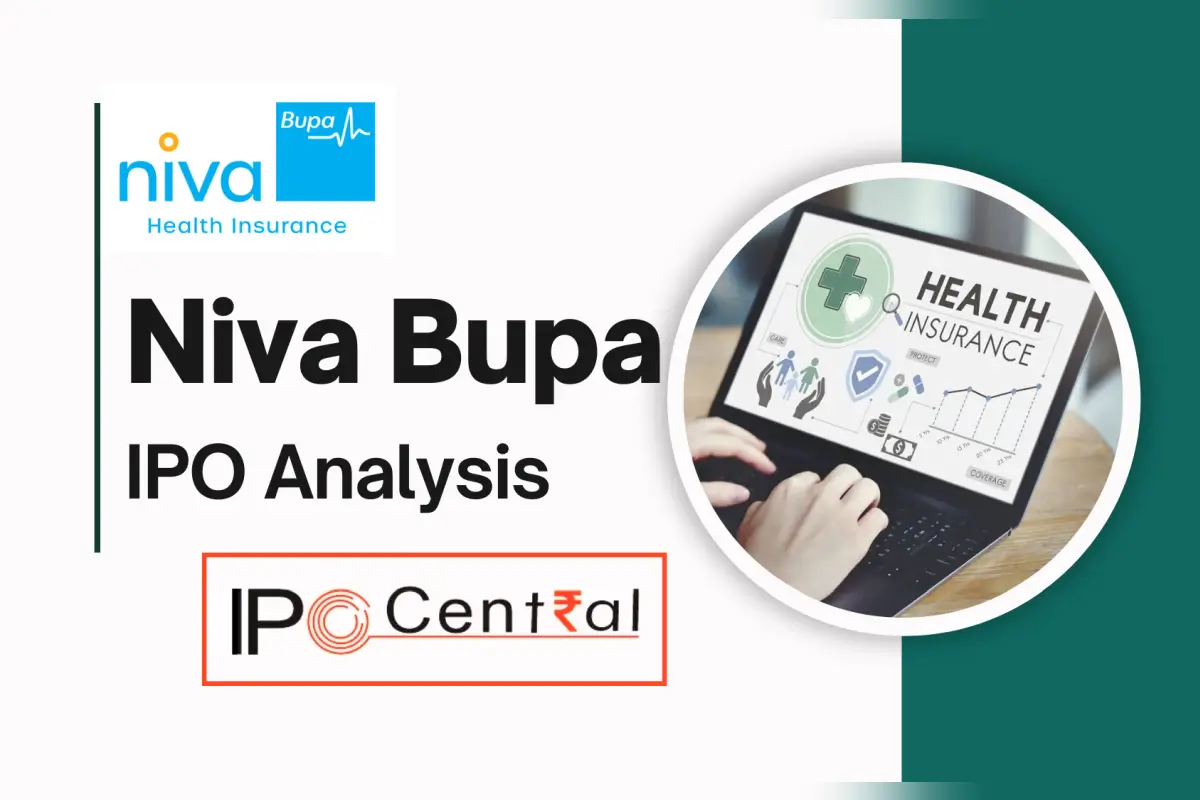| Niva Bupa Health Insurance IPO GMP | Niva Bupa Health Insurance IPO Subscription |
The upcoming Initial Public Offering (IPO) of Niva Bupa Health Insurance Company, set to open on 7 November 2024, presents a significant opportunity for investors. Here is the Niva Bupa IPO analysis that contains crucial points from the Red Herring Prospectus (RHP) that potential investors should consider before making their investment decisions.

Table of Contents
Niva Bupa IPO Analysis: Niva Bupa and the India’s Insurance Landscape
India’s insurance sector is poised for significant growth, projected to expand at an average rate of 7.1% from 2024 to 2028, outperforming the global average of 2.4%. Driven by a growing middle class, regulatory support, and technological innovation, it aims to enhance insurance penetration, currently at 3.8% of GDP.
As of 30 June 2024, Niva Bupa Health Insurance had 1.50 crore active lives insured, with 67.65% of its Gross Written Premium (GWP) derived from retail health products. The company has experienced significant growth, with an overall GWP CAGR of 41.27% from Fiscal 2022 to Fiscal 2024, and a market share of 17.29% in the Standalone Health Insurance (SAHI) sector as of August 2024. The retail health segment is particularly promising due to higher premiums and renewal rates compared to group health insurance, making it a key focus for the company moving forward.
Niva Bupa IPO Analysis: IPO Structure and Size
Niva Bupa’s IPO aims to raise INR 2,200 crore, comprising:
Fresh Issue: INR 800 crore through issuing 10.81 crore new shares.
Offer for Sale (OFS): INR 1,400 crore, with shares sold by promoters including Bupa Singapore Holdings Pte and Fettle Tone LLP.
This structure indicates a blend of capital raising and liquidity provision for existing shareholders.
Niva Bupa IPO Analysis: Price Band and Lot Size
The price band for the IPO is set between INR 70 – 74 per share. The minimum investment for retail investors is INR 14,800, based on a lot size of 200 shares. This pricing strategy is designed to attract a broad base of retail investors as well as institutional participation.
Niva Bupa IPO Analysis: Important Dates
Key dates related to the IPO are as follows:
Opening Date: 7 November 2024
Closing Date: 11 November 2024
Allotment Date: 12 November 2024
Listing Date: 14 November 2024
These timelines are essential for investors planning their participation in the IPO process
Niva Bupa IPO Analysis: Financial Performance
Niva Bupa has shown robust growth in its financials:
Net Profit: Reported at INR 81.85 crore for FY24, a significant rise from INR 12.5 crore in FY23.
Revenue: The company’s revenue grew from INR 2,662.75 crore in FY 2023 to INR 3,811.25 crore in FY 2024. However, it incurred losses of INR 18.82 crore in the first quarter of FY25, indicating volatility in its profitability.
Niva Bupa IPO Analysis: Utilization of Proceeds
- Capital Augmentation: The net proceeds from the fresh issue will augment the capital base, ensuring compliance with the minimum solvency ratio requirement of 1.50x, as mandated by the IRDAI. As of 30 June 2024, Niva Bupa reported a solvency ratio of 2.39x, indicating a healthy capital position. The funds raised will help sustain this strong solvency margin.
- General corporate purposes aimed at enhancing operational capabilities and market competitiveness.
Niva Bupa IPO Analysis: Strengths
Average Premium per Insurance Policy: Niva Bupa Health Insurance generates revenue primarily through premiums from health insurance policies. The company has increased the percentage of new retail health indemnity policies with sums insured of INR 10 lakh or more to 73.66% as of 30 June 2024, up from 70.72% in Fiscal 2024. This trend allows for higher premiums per policy, driving growth in underwritten insurance premiums.
Renewal Rate: Niva Bupa Health Insurance emphasizes the importance of customer retention alongside acquiring new clients for sustainable growth. The renewal rate for retail health indemnity policies reached 90.24% as of 30 June 2024, and 92.15% in Fiscal 2024. Retaining existing customers is crucial, as renewal costs are typically lower than those for new policy acquisitions, helping to control expenses and enhance profitability.
Product Mix: Niva Bupa Health Insurance is focused on developing a robust retail health insurance portfolio, which is considered the most promising segment in India due to higher premiums, renewal rates, and lower combined ratios compared to group insurance. As of 30 June 2024, the company’s GWP from retail health increased to INR 1,016.91 crore, up from INR 769.63 crore the previous year.
Additionally, Niva Bupa is expanding its group business through SME employer-employee products, which are more profitable due to better risk pricing from access to customer data. The share of GWP from group business rose to 30.55% in the same period.
Niva Bupa IPO Analysis: Risk Factors
Investors should be aware of several risk factors highlighted in the RHP:
- Niva Bupa Health Insurance faces various outstanding legal proceedings involving the company and its directors, including criminal and civil litigations. While these may divert management resources and impact financial conditions. The aggregate amount involved is approximately INR 245.54 crore.
- Niva Bupa Health Insurance acknowledges that its historical growth rates may not predict future performance and emphasizes the uncertainty of achieving continued growth. The company reported significant increases in GWP over recent periods, but it cannot guarantee that this trend will persist.
- Niva Bupa Health Insurance faces contingent liabilities totalling INR 100.70 crore as of 30 June 2024, primarily from statutory demands and claims under policies not acknowledged as debts. These liabilities could adversely affect the company’s financial condition and operations if they materialize, highlighting the potential risks associated with ongoing legal disputes and claims.
- Niva Bupa Health Insurance’s subordinated debt ratings of CARE AA/Stable could be adversely affected by any downgrade or negative outlook, which may increase borrowing costs and negatively impact the company’s financial condition.
- Niva Bupa Health Insurance has clarified that it will not receive any proceeds from the Offer for Sale. Instead, the entire proceeds from this offering will be received by the Selling Shareholders.
Niva Bupa IPO Analysis: Comparison with Listed Peers
Here is the comparison of the Niva Bupa with the listed peers:
| Name of the Company | EPS | Net Profit (INR Crore) | Net Worth (INR Crore) | RoNW (%) | P/E | NAV |
|---|---|---|---|---|---|---|
| Niva Bupa Health Insurance | 0.50 | 81.85 | 2,049.59 | 5.68% | 165.18 | 12.06 |
| Star Health and Allied Insurance | 14.19 | 845.01 | 6,341.62 | 14.35% | 38.27 | 108.35 |
| ICICI Lombard General Insurance | 38.78 | 1,918.59 | 11,959.78 | 17.17% | 48.91 | 242.75 |
| The New India Assurance | 6.77 | 1,091.12 | 21,844.33 | 5.13% | 28.62 | 132.55 |
Niva Bupa IPO Analysis: Promoters and Shareholding
Here is the requested table summarizing the category of shareholders before and after the offer:
| Promoters | Pre-Offer No. of Equity Shares (Face Value of ₹10) | Percentage of Pre-Offer Paid-Up Equity Share Capital (%) |
|---|---|---|
| Bupa Singapore Holdings Pte.* | 1,069,987,767 | 62.19# |
| Bupa Investments Overseas | Nil | N.A |
| Fettle Tone LLP* | 461,020,811 | 26.80 |
| Total | 1,531,008,578 | 88.99 |
#Includes 20 Equity Shares held by David Martin Fletcher as a nominee of Bupa Singapore Holdings Pte.
Niva Bupa IPO Review: What Key Performance Ratios Indicate
The Return on Net Worth (RoNW) for FY 2024 stands at 5.7%, indicating profitability, although this figure is relatively modest compared to industry peers like Star Health at 14.4% and ICICI Lombard at 17.2%. Niva Bupa’s debt-to-equity ratio is low at 0.12, reflecting a conservative approach to financing that enhances its financial stability. Additionally, Niva Bupa has successfully transitioned from a net loss of INR 196.53 crore in FY 2022 to a net profit of INR 81.85 crore in FY 2024.
Conclusion
In conclusion, while Niva Bupa’s IPO presents an attractive investment opportunity with significant growth potential in a burgeoning market, investors should carefully consider the associated risks and conduct thorough due diligence based on the insights provided before making their investment decisions.






































